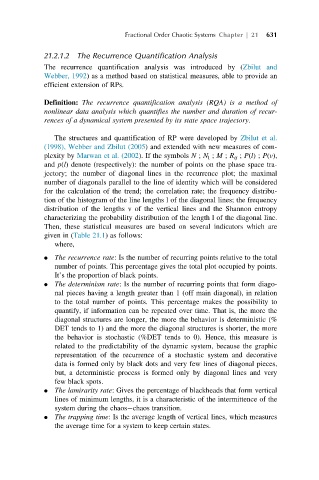Page 660 - Mathematical Techniques of Fractional Order Systems
P. 660
Fractional Order Chaotic Systems Chapter | 21 631
21.2.1.2 The Recurrence Quantification Analysis
The recurrence quantification analysis was introduced by (Zbilut and
Webber, 1992) as a method based on statistical measures, able to provide an
efficient extension of RPs.
Definition: The recurrence quantification analysis (RQA) is a method of
nonlinear data analysis which quantifies the number and duration of recur-
rences of a dynamical system presented by its state space trajectory.
The structures and quantification of RP were developed by Zbilut et al.
(1998), Webber and Zbilut (2005) and extended with new measures of com-
plexity by Marwan et al. (2002). If the symbols N ; N l ; M ; R ij ; P(l); P(v),
and p(l) denote (respectively): the number of points on the phase space tra-
jectory; the number of diagonal lines in the recurrence plot; the maximal
number of diagonals parallel to the line of identity which will be considered
for the calculation of the trend; the correlation rate; the frequency distribu-
tion of the histogram of the line lengths l of the diagonal lines; the frequency
distribution of the lengths v of the vertical lines and the Shannon entropy
characterizing the probability distribution of the length l of the diagonal line.
Then, these statistical measures are based on several indicators which are
given in (Table 21.1) as follows:
where,
The recurrence rate: Is the number of recurring points relative to the total
number of points. This percentage gives the total plot occupied by points.
It’s the proportion of black points.
The determinism rate: Is the number of recurring points that form diago-
nal pieces having a length greater than 1 (off main diagonal), in relation
to the total number of points. This percentage makes the possibility to
quantify, if information can be repeated over time. That is, the more the
diagonal structures are longer, the more the behavior is deterministic (%
DET tends to 1) and the more the diagonal structures is shorter, the more
the behavior is stochastic (%DET tends to 0). Hence, this measure is
related to the predictability of the dynamic system, because the graphic
representation of the recurrence of a stochastic system and decorative
data is formed only by black dots and very few lines of diagonal pieces,
but, a deterministic process is formed only by diagonal lines and very
few black spots.
The lamirarity rate: Gives the percentage of blackheads that form vertical
lines of minimum lengths, it is a characteristic of the intermittence of the
system during the chaos chaos transition.
The trapping time: Is the average length of vertical lines, which measures
the average time for a system to keep certain states.

